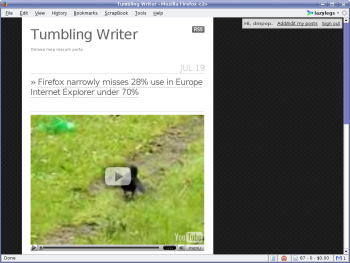Author: Dmitri Popov
You may be forgiven for thinking that a tumblelog is just a blog for lazybones. While there are a lot of similarities between these two kinds of content management systems, a tumblelog is more like an online basket, which you can use to collect your thoughts and discoveries and share them with others. Unlike with blogs, tumblelog readers don’t expect you to provide any commentary in the published items, so you don’t actually have to “blog about” the stuff that you publish. The idea is that the post item itself implicitly expresses your opinion on it, or, to put it in a slightly different way, you let the item speak for itself.
To better understand how a tumblelog works in practice, try gelato (which means ice cream in Italian), an open source tumblelog software that runs on the PHP/MySQL stack and offers all the basic tumblelogging features. While at version 0.85 gelato is far from finished and contains a few bugs and quirks, it allows you to set up your own tumblelog in a matter of minutes.
Since gelato is a PHP/MySQL-based application (with a touch of AJAX), its installation procedure is similar to that of any other Web-based application. You start by creating a MySQL database for use with gelato. Next, download the latest release of the application and unpack it. In the resulting directory, locate the config-sample.php file and rename it config.php, then enter the required database connection settings in it. Upload the entire directory to your server, and point your browser to http://server/gelato/install.php. An installation wizard will guide you through the rest of the setup process. Once gelato is installed, make sure that its uploads directory is writable by the server (chmod 777), and you are done.
Now you can log in to your freshly installed gelato tumblelog and start adding stuff. The first thing you’ll notice is that unlike a blog, gelato divides content into different types. Instead of creating a new generic post, you have options to publish photos, movies, audio, links, quotations, and dialogs. You can also create a conventional blog-like post using the Regular sections. The main purpose of this differentiation is to give authors the ability to quickly publish content without fiddling with formatting options. In most cases, the only thing you need to do is to provide a link to the content item, and enter an optional description. For example, to post a YouTube movie, you only need to type its URL, and gelato takes care of embedding it into your tumblelog. With photos, you can either upload a photo from your local hard disk or give gelato a URL to fetch the picture.
While blogging and commenting is not the primary focus in a tumblelog, gelato does support Textile, a lightweight markup language that gives you some basic text formatting options. Using it, you can not only stylize text, but also insert tables, links, and inline images — all of which help you format posts in a more conventional way.
The administration section of gelato is not exactly brimming with features, but you have to keep in mind that the software is designed with ease of use as its primary goal. Still, it provides essential features such as the ability to manage published articles, modify the tumblelog’s settings, and manage users.
The current version of gelato supports themes, while the support for plugins is scheduled for the next version. The selection of themes is limited to say the least, but some of them look good. Installing a new theme is as easy as it gets: Download a theme package, unpack it, and move it into the themes directory inside your gelato installation. Go to the Settings section, select the added theme, and press Modify.
Final word
Tumblelogs may turn out to be just another flavor of the day, but for some users they provide a way to effortlessly collect and share findings, thoughts, and ideas. If this is what you are looking for, and you’d like to have full control of your tumblelog, gelato is a good choice.
Category:
- Internet & WWW



